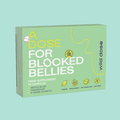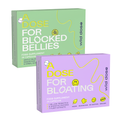Why Does Lactose Cause Bloating?
Lactose is a sugar that is abundant in milk and other dairy products. Most people are able to effectively break down the lactose sugars that they consume in their diets, but for some, it isn’t so simple.
Lactose intolerance is a condition that affects millions of people worldwide, and it can lead to excess gas production, bloating, and abdominal cramps.
Normally, an enzyme called lactase is responsible for breaking down lactose sugars when you ingest them in foods and drinks. However, if your body produces limited amounts of lactase, it can lead to lactose intolerance and a range of negative digestive symptoms. Some people don’t produce any lactase enzymes at all, so they either need to supplement or avoid consuming lactose in their diet altogether.
In this article, we’re going to cover what lactose intolerance is in more detail. We’ll also discuss why lactose causes bloating, what the key signs and symptoms of lactose intolerance are, and how you can reduce bloating quickly when you eat lactose.
What Are Lactose and Lactose Intolerance?
Lactose is a sugar that is present in milk and dairy products. It’s also found in human breast milk. It comprises two smaller sugars, glucose and galactose, which are linked together to form lactose.
Lactose intolerance is a relatively common condition that affects around two-thirds of the global population. It is more prevalent in certain ethnic groups, including African Americans, Asians, and Hispanics, and is less common in populations of Northern European descent.
It occurs when the body is unable to fully digest lactose due to a deficiency in lactase, the enzyme responsible for breaking down lactose. Lactase is normally produced in the small intestine and breaks down lactose into its component (glucose and galactose) when you ingest milk or dairy products.
With a lactase enzyme deficiency, the body is less able to metabolise lactose, so it passes through the digestive system undigested. This can cause a range of digestive symptoms, including excessive gas, bloating, and painful cramps.
How is Lactose Intolerance Diagnosed?
If you suspect that you have an intolerance to lactose, contact a doctor or dietician. They will take a full medical history from you and perform a variety of tests to confirm or eliminate a lactose intolerance diagnosis.
Some common tests that doctors and dieticians use to check for lactose intolerance include the lactose tolerance test, the hydrogen breath test, and the stool, acidity test.
1. Lactose tolerance test
The lactose tolerance test involves fasting for eight hours before drinking a liquid that contains lactose. A series of blood samples will then be taken over a two-hour period to check your blood glucose levels.
If your blood sugar concentration doesn’t increase after you have the lactose-containing drink, you might be intolerant. The lack of glucose in your bloodstream indicates that your body is not breaking down the lactose into glucose and galactose as it should, so doctors can confirm a lactose intolerance diagnosis using this method.
2. Hydrogen breath test
Doctors may also use the hydrogen breath test to diagnose lactose intolerance. With the hydrogen breath test, you will be given a drink that contains high amounts of lactose. Your breath will be checked several times to identify the presence or absence of hydrogen.
If the hydrogen levels in your breath rise above a certain threshold, it indicates that you aren't digesting the lactose very well and that you may have lactose intolerance or a similar digestive disorder. A hydrogen breath test may also be used to diagnose small intestinal bacterial overgrowth (SIBO) and other gastrointestinal disorders.
3. Stool acidity test
Another common test is the stool acidity test, which is commonly used to diagnose lactose intolerance in infants and young children. If you’re not digesting lactose properly because you lack sufficient amounts of lactase, your stool will contain lactic acid, glucose, and other fatty acids.
Why Does Lactose Cause Bloating?
When your body isn’t able to fully digest lactose, it moves through your digestive tract more slowly. Because of this, it spends more time sitting in the colon, where your gut bacteria ferment it. Fermentation causes gas production, leading to bloating and other digestive symptoms.
The severity of bloating that you experience after consuming foods and drinks that contain lactose if you are intolerant will depend on your level of intolerance. Your gut health, age, and genetics can also impact your risk of lactose-associated bloating.
What Are the Signs of a Lactose Intolerance?
The symptoms of lactose intolerance vary from person to person. However, common symptoms include:
- Excess gas
- Bloating
- Nausea
- Abdominal cramps
- Diarrhoea
How to Consume Lactose Without Getting Digestive Symptoms
If you’re experiencing any of the above symptoms, you should go and see a healthcare professional as soon as you can. A qualified medical professional (ideally, a doctor or dietician) will be able to run the necessary tests to identify whether you have lactose intolerance or not.
Although there is no cure for lactose intolerance, there are lots of simple things that you can do to manage your condition. You can use natural remedies to relieve bloating and excess gas and make positive dietary changes to avoid triggers.
Here are some effective ways to manage your lactose intolerance and any associated digestive symptoms that you might experience after eating milk or dairy.
1. Consume products with low amounts of lactose
Different dairy products contain different amounts of lactose. Hard cheeses and yoghurt contain some of the lowest amounts of lactose out of all dairy products, so your symptoms might be minimal if you consume these foods.
2. Choose plant-based milk over cow’s milk
It’s best to avoid dairy milk and, instead, choose one of the many plant-based milk options. You can choose from soya, almond, hazelnut, cashew, or coconut milk.
Of course, you can also purchase lactose-free milk. This type of milk tastes like cow’s milk but either has the lactose removed or lactase enzymes added to reduce the risk and severity of digestive symptoms in those with lactose intolerance.
3. Read food labels
Milk and dairy are common ingredients in a wide range of foods. They are often ‘hidden’ ingredients that are added to non-dairy foods, and you’d only know that they’re in these foods if you check the labels.
Get into the habit of checking the labels of every food you eat, so you can avoid lactose-containing foods as much as possible and help with bloating. You might not find the word ‘lactose’ on a food label. Instead, you might see:
- Milk
- Dried milk
- Milk powder or powdered milk
- Cream
- Butter
- Whey protein
Each of the above ingredients contains lactose and could trigger your symptoms if you’re lactose intolerant. Wherever possible, avoid foods with these ingredients to keep your digestive symptoms to a minimum.
How to Reduce Bloating After Eating Lactose
Whether you’ve accidentally or purposefully eaten lactose-containing foods, you might experience excessive gas and bloating as a result. Here are some of the many things that you can do to reduce lactose-associated bloating.
1. Take lactase supplements
Lactase supplements are an over-the-counter treatment for lactose intolerance. They contain the enzyme lactase, which supports your body in breaking down lactose. You should take lactase supplements before you eat any foods or drinks that contain milk or dairy products to reduce your symptoms.
2. Eat smaller, more frequent meals
Eating smaller, more frequent meals can help reduce bloating caused by lactose intolerance. It enables your body to fully break down the lactose in the foods and drinks that you consume more efficiently.
3. Avoid trigger foods
Some people with lactose intolerance also have trouble digesting other types of foods, such as high-fat foods, beans, legumes, and cruciferous vegetables. Pay attention to what foods cause you to become bloated and try to avoid them wherever possible.
4. Take a probiotic supplement
Probiotics are live bacteria that are beneficial for your digestive system. Probiotic bacteria include Bifidobacterium and Lactobacillus.
Taking a probiotic supplement, can aid your digestive system and improve the efficiency of your digestive processes. You can also get probiotics from fermented foods like yogurt, sauerkraut, tofu, tempeh, and kefir.









